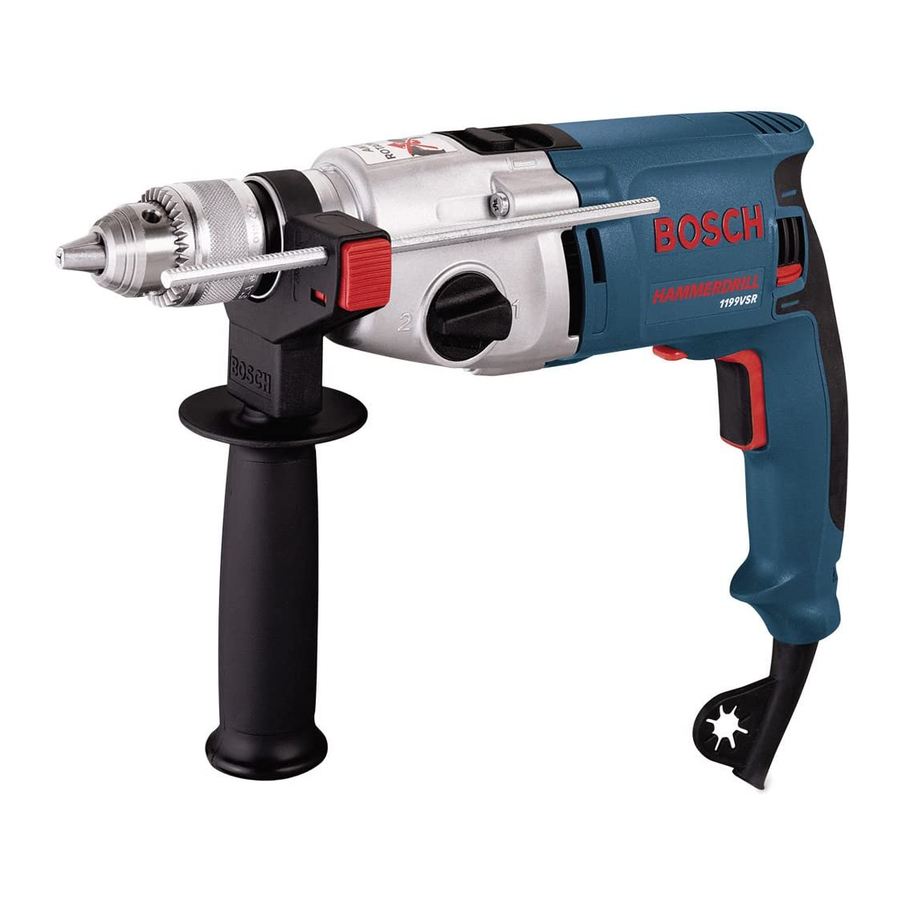Bosch 1199VSR - NA VSR 1/2" Dual Torque Hammer Drill Gebruiksaanwijzing/veiligheidsinstructies - Pagina 8
Blader online of download pdf Gebruiksaanwijzing/veiligheidsinstructies voor {categorie_naam} Bosch 1199VSR - NA VSR 1/2" Dual Torque Hammer Drill. Bosch 1199VSR - NA VSR 1/2" Dual Torque Hammer Drill 33 pagina's. Bosch operating/safety instructions hammer drill 1199vsr
Ook voor Bosch 1199VSR - NA VSR 1/2" Dual Torque Hammer Drill: Snelle referentiehandleiding (25 pagina's)

INSERTING BIT
For small bits, open jaws enough to insert the
bit up to the flutes. For large bits, insert the bit
as far as it will go. Center the bit as you close
the jaws by hand. This positions the bit
properly, giving maximum contact between the
chuck jaws and the bit shank.
To tighten chuck, insert key into each of the
three key holes in succession and tighten
clockwise firmly. The chuck can be released by
using one hole only (Fig. 4).
You will extend the life of your bits and do
neater work if you always put the bit in contact
with the work before pulling the trigger. During
the operation, hold the tool firmly and exert
light, steady pressure. Too much pressure at
low speed will stall the tool. Too little pressure
will keep the bit from cutting and cause excess
friction by sliding over the surface. This can be
damaging to both tool and bit.
DRILLING WITH VARIABLE SPEED
The trigger controlled variable speed feature
will eliminate the need for center punches in
hard materials. The variable speed trigger
FASTENING WITH SCREWS
The procedure shown in (Fig. 5) will enable
you to fasten materials together with your
hammer drill in the drill mode without
stripping, splitting or separating the material.
First, clamp the pieces together and drill the
first hole 2/3 the diameter of the screw. If the
material is soft, drill only 2/3 the proper
length. If it is hard, drill the entire length.
Second, unclamp the pieces and drill the
second hole the same diameter as the screw
shank in the first or top piece of wood.
Third, if flat head screw is used, countersink
the hole to make the screw flush with the
surface. Then, simply apply even pressure
when driving the screw. The screw shank
clearance hole in the first piece allows the
screw head to pull the pieces tightly
together.
Counter
Clockwise
FIG. 4
Operating Tips
allows you to slowly increase RPM. By using a
slow starting speed, you are able to keep the
bit from "wandering". You can increase the
speed as the bit "bites" into the work by
squeezing the trigger.
DRIVING WITH VARIABLE SPEED
Variable speed drills will double as a power
screwdriver by using a screwdriver bit in the
drill mode. The technique is to start slowly,
increasing the speed as the screw runs down.
Set the screw snugly by slowing to a stop. Prior
to driving screws, pilot and clearance holes
should be drilled.
The adjustable screw drill accessory will do
all of these operations quickly and easily.
Screw drills are available for screw sizes No.
6, 8, 10 and 12.
FASTENING
WITH SCREWS
1. Drill 2/3 diameter and
2/3 of screw length for
soft materials, full
length for hard
materials.
Screw
Apply a slight
even pressure
when driving
screws.
-8-
Clockwise
2. Drill same
diameter as
screw shank.
3. Countersink
same diameter
as screw head.
Adjustable
Screw
Drill
FIG. 5
